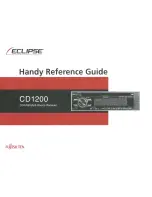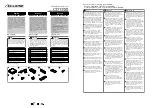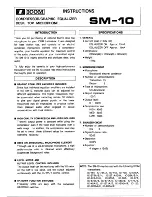
STH-DCSG
U
SER
’
S
M
ANUAL
©
2005
V
IDERE
D
ESIGN
4
1 Introduction
The STH-DCSG is a compact, low-power digital stereo head with an IEEE
1394 digital interface. It consists of two 640x480 (VGA), progressive scan
CMOS imagers mounted in a rigid body, and a 1394 peripheral interface
module, joined in an integral unit.
The CMOS imagers have a
global shutter
– all pixels are exposed at exactly
the same time (the “G” in DCSG). This makes the STH-DCSG suitable for
environments with fast movement, such as on an outdoor vehicle.
The CMOS imagers are MT9V022 sensors from Micron Semiconductor..
They are 1/3” format, with a resolution of 640 H by 480 V pixels, and come
in either monochrome (STH-DCSG) or colorized (STH-DCSG-C) versions.
These imagers have excellent dynamic range, sensitivity, anti-blooming,
and noise characteristics. They are fully controllable via the 1394 interface:
the user can set exposure, gain, decimation, etc. They have better noise,
sensitivity, and crosstalk characteristics than the previous sensors.
The STH-DCSG/-C uses standard C/CS-mount lenses for user-changeable
optics. Wide-angle to telephoto options are available, depending on the
application.
The variable baseline version of the STH-DCSG/-C uses the same imagers,
but has a separate IEEE 1394 interface for each imager. It has similar
characteristics to the STH-DCSG/-C; please see the STH-DCSG-VAR/-C
manual for more information.
SRI’s Small Vision System (SVS) software has an interface to the STH-
DCSG/-C, and is included with each stereo head. You can simply and
automatically calibrate the stereo head, perform stereo correlation, and view
the results as a 3D point set. The SVS software includes software drivers
for the STH-DCSG/-C for MS Windows 98SE/ME/2000/XP, and for Linux
2.4.and 2.6 kernels.
1.1 Characteristics
•
Micron MT9V022 CMOS imagers
Global shutter
Simultaneous exposure and readout
640x480 maximum image size
1/3” format
High sensitivity, low noise
Low pixel cross-talk
•
Fully synchronized stereo – left and right pixels are
interleaved in the video stream
•
Monochrome or Bayer Color
•
High frame rates – 30 Hz for 640x480
•
On-chip binning (monochrome only) and decimation –
full frame 640x480 and 320x240 modes
•
Electronic zoom mode – center 320x240 subwindow
•
Extensive control of video parameters
Automatic or manual control of exposure and gain
Automatic control of black level
Manual control of color balance
•
50 Hz mode – reduces indoor light interference in
countries with 50 Hz electrical line frequency
•
Stereo calibration information can be stored on the
device, and downloaded automatically to the PC
•
IEEE 1394 interface to standard PC hardware – carries
power and commands to device, data to PC
•
Standard C/CS mount lenses, interchangeable –
standard focal lengths 2.8, 4.0, and 8.0 mm
•
Fixed 9 cm baseline
•
Anodized aluminum alloy chassis, high rigidity





































